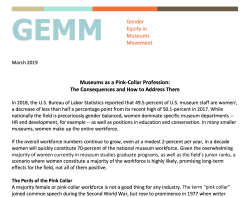Diversity without Intersectionality is a Cart without a Horse
Posted: October 12, 2020 Filed under: Diversity, Gender, Race, Workplace Bias, workplace diversity Leave a comment
I admit it: It’s taken me a long time to wrap my head around intersectionality. When Anne Ackerson and I started writing Women in the Museum five years ago, I would have told you all women experience sexism in the workplace. It’s what unites us. Well, maybe, but in retrospect so is the fact that we all walk upright and most of us have two eyes and two ears.
Even though I was taken to task more than a few times by women of color during the writing of Women in the Museum, I don’t think I really understood intersectionality until this summer. In the aftermath of George Floyd’s murder I heard a Black parent interviewed on NPR. They were talking about giving their children “the talk.” Anyone who has raised children knows parenting provides a wealth of things to worry about. All those worries escalate when children become teenagers, independent beings capable of making spectacularly bad choices. But listening to those parents, I realized my worries while raising two children were minor compared to theirs. So although we are united in parenthood, our experiences are vastly different. Of all the many things I worried about, car accidents, alcohol, bullying, drugs, you name it, I never worried about whether my children would be called out for simply being themselves. They are white, and therefore protected.
The term intersectionality belongs to Kimberlé Williams Crenshaw, a lawyer and civil rights advocate. She introduced it in a 1989 paper presented in Chicago, although she acknowledged it came from generations of Black women writing that, “In every generation and in every intellectual sphere and in every political moment, there have been African American women who have articulated the need to think and talk about race through a lens that looks at gender, or think and talk about feminism through a lens that looks at race. So this is in continuity with that.”¹ Later, she used the metaphor of a traffic intersection, with cars coming from several directions, to describe intersectionality, opining that when an accident occurs, it’s difficult to pinpoint who or what caused it. Just as when a Black woman is talked over, demeaned or harassed at work is it because she’s a woman or because she’s black? Or is it because she’s not in power and someone who’s male is or someone who’s white and male?
There are a lot of museums and heritage organizations hiring Black leaders at the moment, and that’s a good thing, but questions remain: Do organizations do the kind of soul searching they need to do during the hiring process so BIPOC leaders aren’t tokenized or hired to check a box? Here’s what I mean. If a board hires a person of color because it thinks it should, but never addresses its own biases and issues, what happens? The first months may be fine, maybe even the first year, but what happens when implicit bias burbles to the surface? What happens when it’s clear the board’s perception of its first Black director is riddled with preconceptions. The Board may have trouble articulating those feelings because board meetings are not generally the place for feelings. Yet without unpacking what’s happened, both leader and Board begin an alliance based on misunderstanding.
And what if the leader is a woman of color? What if the Board also has issues with gender, issues it’s never copped to? What if, in their heart of hearts, they perceive women as less competent, prone to emotions, possibly more devoted to family than being a director, and maybe not leadership material? That’s a dire picture, but it’s the “and also” of intersectionality. Women sometimes face an uphill battle when it comes to leadership, but women of color must also combat the additional lens of race, that’s often masked in the urbane, left-leaning world of museums. And women’s workplace experiences vary drastically, so boards, HR departments and museum leadership need to do more than congratulate themselves for stepping outside the box and hiring a candidate of color.
One of our Johns Hopkins Museum Studies students remarked this week how important it is to be able to come to work as your whole self. Too true. Some museum staffers have always had that luxury. And that’s the inflection point between diversity and intersectionality. Knowing your staff reflects your community and the world as we know it is important. That’s the cart. But the horse is offering the respect and support for each of those individuals to bring their whole being to work, and to feel supported in what they do. That’s the horse.
As we work to right the wrongs of more than a century of overpowering patriarchal whiteness and classism in museums and heritage organizations, we need to be mindful of not only creating a diverse workplace, but an equitable and supportive one as well. Inviting someone to the table isn’t enough. Sometimes the rules are mysterious, opaque, and strange. We owe it to every creative, diverse soul who works with us to offer them the support and the path, the cart and the horse, to navigate the museum world.
Stay safe.
Joan Baldwin
¹New Statesman. Retrieved 10.11.20. https://www.newstatesman.com/lifestyle/2014/04/kimberl-crenshaw-intersectionality-i-wanted-come-everyday-metaphor-anyone-could









